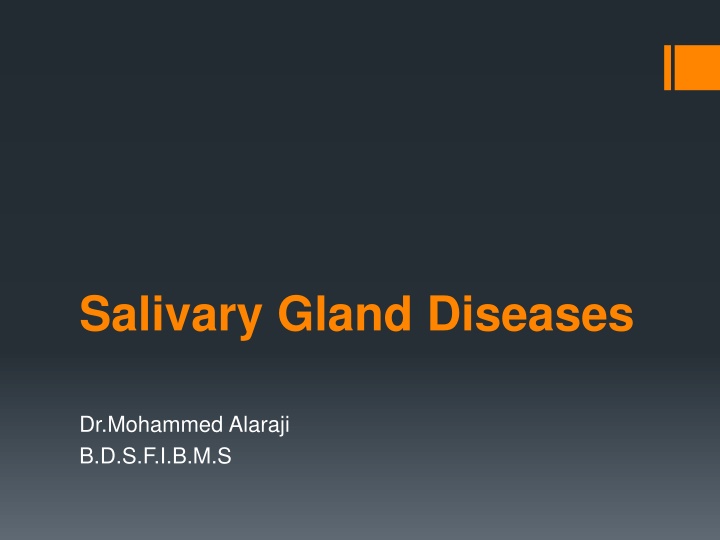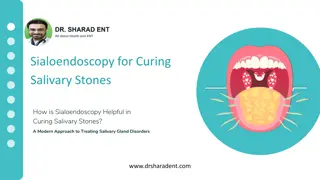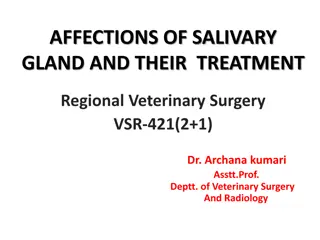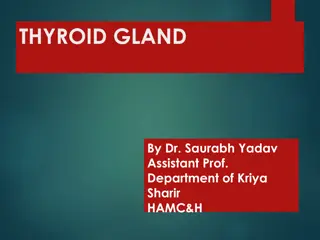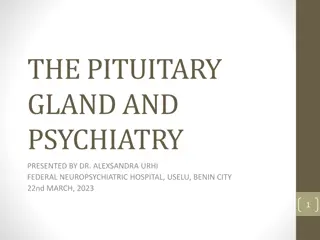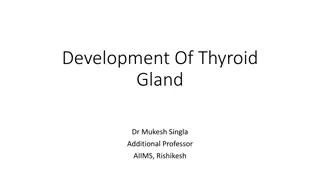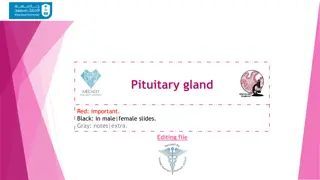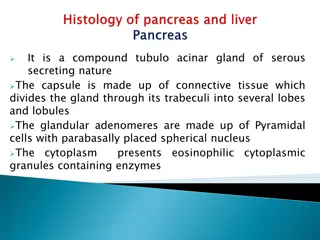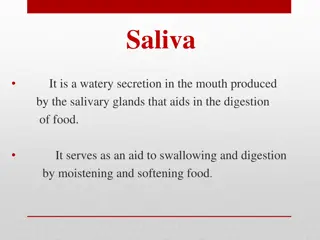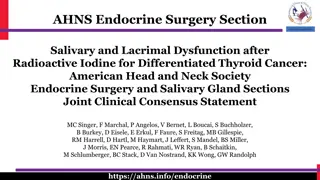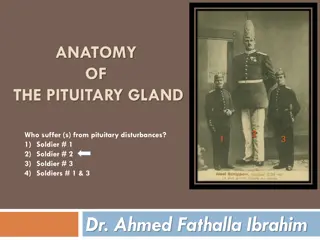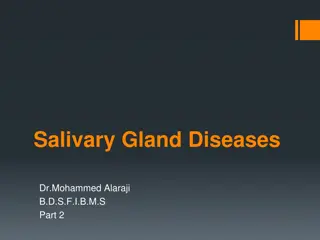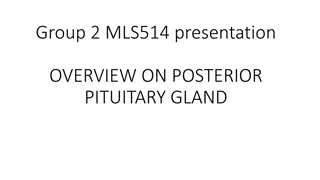Comprehensive Overview of Salivary Gland Diseases and Management
Salivary gland diseases encompass various conditions affecting the salivary glands, including developmental abnormalities, inflammatory and non-inflammatory enlargement, cysts, tumors, and dysfunction. Investigations such as plain films, sialography, MRI, and biopsies are essential for diagnosis. Sialolithiasis, the formation of salivary stones, can lead to obstruction and infection. Clinical features include pain, swelling, and infection, with management options ranging from gland manipulation to surgical removal of larger stones.
Download Presentation

Please find below an Image/Link to download the presentation.
The content on the website is provided AS IS for your information and personal use only. It may not be sold, licensed, or shared on other websites without obtaining consent from the author.If you encounter any issues during the download, it is possible that the publisher has removed the file from their server.
You are allowed to download the files provided on this website for personal or commercial use, subject to the condition that they are used lawfully. All files are the property of their respective owners.
The content on the website is provided AS IS for your information and personal use only. It may not be sold, licensed, or shared on other websites without obtaining consent from the author.
E N D
Presentation Transcript
Salivary Gland Diseases Dr.Mohammed Alaraji B.D.S.F.I.B.M.S
CLASSIFICATION I. Developmental: 1.Aplasia-absence of the gland 2.Atresia-absence of the duct 3.Aberrancy- ectopic gland
II. Enlargement of the gland: A. Inflammatory: 1. Viral: Mumps, coxsackieA. CMV, 2.Bacterial 3.Allergic 4.Sarcoidosis 5.Obstructive B. Non-inflammatory: 1.Autoimmune: Sj gren's syndrome 2.Alcoholic cirrhosis 3.Diabetes mellitus 4.Nutritional deficiency 5.HIV associated
III. Cysts: 1.Extravasation cysts 2.Retention cysts 3.Ranula IV. Tumors of salivary glands: A. Benign tumors 1.Pleomorphic adenoma 2. Warthin's tumor B. Malignant tumors 1. Mucoepidermoid carcinoma 2.Adenoid cystic carcinoma V. Necrotizing sialometaplasia VI. Salivary gland dysfunction 1. Xerostomia 2. Sialorrhea
Investigations 1. Plain films. 2. Sialography 3. USS: 4. MRI 5. CT 6. FNA 7. Needle core biopsy 8. Scintigraphy 9. Sialadenoscopy
SIALOLITHIASIS Is the formation of sialolith (salivary calculi, salivary stone) in the salivary duct or the gland resulting in the obstruction of the salivary flow. Sialolith: is a calcareous substance, which may form in the parenchyma or the duct of the major or minor salivary glands. It results from the crystallization of salivary solutes. This is because the long, curved Wharton's duct has increased chance of entrapment of organic debris, plus the secretion of this gland is higher in calcium content and thick in consistency and the position of the gland increases the chances for the stagnation of the saliva The factors like inflammation; local irritation or drugs can cause stagnation of saliva leading to the build up of an organic nidus, which eventually will calcify.
Clinical Features 1. Adults are mainly affected, males twice as often as females. 2. Calculi are usually unilateral. Symptoms are absent until the stone causes obstruction. Intermittent obstruction causes the classical symptom of meal time syndrome , pain and swelling of the gland when the smell or taste of food stimulates salivary secretion. 3. Persistent obstruction leads to infection, pain and chronic swelling of the gland. Otherwise there are no symptoms unless the stone passes forward and can be palpated or seen at the duct orifice. Alternatively, the stone may be seen in a radiograph.
Management 1. The smaller sialoliths, which are located peripherally near the ductal opening may be removed by manipulation (Called milking the gland). 2. Larger sialoliths are surgically removed 3. the intubation of the duct with fine soft plastic catheter and application of the suction to the tube. 4. Multiple stones or stones in the gland require the removal of the gland. 5. Piezoelectric shockwave lithotripsy
SIALADENITIS Inflammation of the salivary glands is known as sialadenitis. Viral infections, bacterial infections, allergic reactions and systemic diseases are the major causes for sialadenitis. It may be acute or chronic.
Viral Infections Mumps (Epidemic parotitis) is the most common viral infection affecting the salivary glands; It is highly infectious which is caused by a paramyxovirus. This disease is self-limiting one and not dangerous. In these days, the number of cases is reduced, because of the use of the mumps vaccine incubation period of 2-3 weeks.
Clinical features 1. Initially, the patient may suffer from mild fever, headache, chills, vomiting, etc. followed by pain below the ear and sudden onset of firm, rubbery or elastic swelling of the salivary glands, frequently elevating the ear lobe 2. Xerostomia, trismus, cervical lymphadenitis, tender glands, edema of the overlying skin may also be present. 3. Management: It is self-limiting. Symptomatic relief can be given by antipyretics Antibiotics can be given to prevent the secondary infection
Bacterial infection Acute Bacterial Sialadenitis viridans. Staph. aureus, Staph. pyogenes, Strep. nuemococcus, Actinomycetes It affects either the neonate and children or debilitated adults with poor oral hygiene. Some drugs like tranquilizers, antiparkinson drugs, diuretics, anti-histamines, tricyclic antidepressants, etc. decrease the salivary flow, with increased chance of infection of salivary glands
Clinical features 1. sudden onset of pain at the angle of the jaw, which is unilateral. 2. The affected gland is enlarged and tender and extremely painful. The inflammatory swelling is very tense and doesn't show much Fluctuation. 3. The overlying skin is warm and red. There is purulent discharge from stenson,s s duct, which can be seen upon pressing the papilla. 4. Patient might present with fever and other symptoms of acute inflammation.
Investigation leukocyte count is high-leukocytosis culture and sensitivity test
Management 1. Antibiotics . 2. Palliative a. Hydrating the patient. b. Stimulate the salivation by chewing sialogogues. c. Improve the oral hygiene . 3-Surgical drainage may be done using needle aspiration guided by CT scan or ultrasonography
Chronic Bacterial Sialadenitis It may be idiopathic or with factors like duct obstruction, congenital stenosis, Sj grens syndrome and viral infection The microorganisms may be Strep. viridans, Escherichia coli, Proteus or Pneumococci. Because these have low virulence,
Clinical features It is usually unilateral and asymptomatic or with intermittent painful swelling of one gland. Sialography may show dilatation of ducts behind the obstruction, with tortuous distorted ducts compressed by fibrosis. The gland may undergo atrophy, which results in decreased salivary flow
Management .Antibiotics Intraductal infusion of erythromycin or tetracycline . In intractable cases, excision of the gland.
CYSTS OF THE SALIVARY GLANDS Two types are the mucous extravasation cyst which occurs because of the pooling of mucus, it does not have any epithelial lining and is surrounded by connective tissue cells 1. Mucocele is a cavity filled with mucus of minor salivary gland.. 2. Ranula Etiology: Mainly due to either obstruction of a salivary duct or trauma.
Mucocele Majority of mucocele are seen to affect the lower lip. With the exception of the anterior half of the hard palate which is devoid of salivary glands. They can occur anywhere in the oral cavity, i.e. cheeks, ventral surface of the tongue, floor of the mouth and retromolar area.
Clinical features Small superficial, painless, well circumscribed swellings on the mucosa. Often vary in size from 1 mm to 2 cm. In deep seated, fluctuation is positive. Color is variable, it may be translucent or bluish. The mucocele may rupture spontaneously with the liberation of a viscous fluid. Treatment: Enucleation of mucocele is frequently followed by recurrences. They are best treated by surgical excision together with the associated minor salivary gland tissue and surrounding connective tissue.
Ranula present on the floor of the mouth, beneath the tongue. Owing to its resemblance to a frog's belly, it has been termed ranula. Two types have been identified, i.e. superficial ranula and plunging ranula. Etiology: extravasation of mucous due to trauma to the excretory ducts of the sublingual salivary gland. In the plunging type, this extravasated mucus passes through the mylohyoid muscle and collects in the submandibular region.
Clinical features A dome-shaped bluish swelling of a superficial ranula may be seen located laterally in the floor of the mouth beneath the tongue At times, if the swelling is punctured or traumatized, a mucous secretion may be evident Treatment Marsupialization results in recurrence. It is advisable to surgically remove the sublingual gland from an intraoral approach for both the superficial or plunging variety
TUMORS OF THE SALIVARY GLANDS The tumors of the salivary glands can affect the major and the minor glands. These tumors may be benign or malignant ones. Benign Tumors Pleomorphic adenoma, Warthin's tumor, basal cell adenoma, canalicular adenoma
Typical clinical features of salivary gland tumours Benign salivary gland tumours 1. Slow-growing 2. Soft or rubbery consistency 3. Comprise 85% of parotid tumours. Do not ulcerate. 4. 5. No associated nerve signs. Malignant salivary gland tumours 1. Some are fast-growing and painful, but many are slow growing and asymptomatic. 2. Sometimes hard consistency. 3. Comprise 45% of minor gland tumor. 4. May ulcerate and invade bone. 5. May hypoglossal depending on the site. cause cranial nerve palsies, usually lingual, facial or
Pleomorphic Adenoma Pleomorphic adenoma constitutes more than 50 percent of all tumors and 90 percent of all the benign tumors of the salivary glands. It can affect both the major and minor salivary glands; it commonly affects the parotid gland. Most of the workers believe that the tumor arises from the myoepithelial cell of the salivary gland. The different tissue types of both epithelial and connective tissue elements are seen in the tumor giving the name mixed tumor .
Clinical features Pleomorphic adenoma most commonly affects the parotid gland, followed by minor salivary glands of the palate, lip, less frequently affects the submandibular gland. The tumor starts as a small painless nodule, either at the angle of the mandible or beneath the ear lobe. Tissue destruction, pain or facial paralysis is not seen. The tumor is well circumscribed, encapsulated, firm in consistency, and may show areas of cystic degeneration. The tumor is readily movable without fixity to the deeper tissues or to the overlying skin. The intraoral pleomorphic adenomas, which affect the minor salivary glands of the palate, are noticed early, because of the difficulties in mastication, talking, etc. The palatal pleomorphic adenoma may show fixity to the underlying bone, but does not invade the bone.
Treatment surgical excision. The parotid tumors are removed with adequate margins, whereas the intraoral lesions can be treated little more conservatively.
Warthin's Tumor This benign tumor affects the parotid glands. Involvement of the submandibular or the minor salivary glands is very rare. Usually, males are affected more commonly in the 5th decade.. The diagnosis may be confirmed by biopsy. Treatment: The tumor is surgically excised
Mucoepidermoid Carcinoma The grading of mucoepidermoid carcinoma into: low-grade, intermediate grade highgrade has cleared the doubts about it's behavior. The low-grade tumor . with very good prognosis, whereas the high-grade tumor behaves very aggressive. It occurs with an equal distribution between males and females.
Clinical features depend upon the grade of the tumor. Thus, it may grow slowly or rapidly; usually as a painless swelling of the parotid or other major salivary gland, or in the minor salivary glands. Intraorally, it may affect the minor glands of the palate, buccal mucosa, tongue and retromolar areas. The high-grade tumor may produce pain, ulceration or facial paralysis, local destruction and metastasis to regional lymph nodes and distant metastasis to the lung, bone and to the brain in later stages.
Treatment The tumor should be surgically excised; the excision should be more radical than for pleomorphic adenoma
Adenoid Cystic Carcinoma It may arise as a slow growing swelling, sometimes may mimic a benign tumor clinically and histologically, but has greater potential for local destruction and invasiveness, commonly perineural invasion. Treatment: Adenoid cystic carcinoma is treated by radical excision. As the tumor is radio resistant, irradiation is not a mode of primary treatment.
NECROTIZING SIALOMETAPLASIA Necrotizing sialometaplasia is an inflammatory lesion of unknown etiology, which affects the minor salivary glands. Trauma leading to ischemia, acinar necrosis and squamous metaplasia of the ductal epithelium is thought to be the pathogenesis. Since the lesion mimics a malignant lesion, both clinically and histologically, the diagnosis should be carefully done.
NON-INFLAMMATORY AUTOIMMUNE DISEASE Sj gren's Syndrome This is a condition originally described as a triad, consisting of dry eyes, xerostomia and rheumatoid arthritis. Primary Sj gren s syndrome comprises dry mouth and dry eyes not associated with any connective tissue disease. Secondary Sj gren s syndrome comprises dry mouth and dry eyes associated with rheumatoid arthritis or other connective tissue disease. Though the etiology is unknown, various causes suggested are genetic, hormonal, infection and immuno- logic among others. Most authorities support the immunologic mechanism
Clinical Features: 1. Clinically, this disease occurs predominantly in women over 40 years of age, The female to male ratio is 10:1. 2. Typically, patients present with dry eyes and dry mouth due to hypofunction of lacrimal and salivary glands. This leads to pain, burning sensation and ulcerations on the oral/conjunctival mucosa. 3. Rheumatoid arthritis most frequently accompanies the above symptoms in secondary Sj gren's syndrome. 4. primary Sj gren's syndrome are seen to manifest parotid gland enlargement, purpura, lymphadenopathy 5. Salivary gland function in suspected cases can be measured by using parotid flow rate, biopsy(labial biopsy) and salivary scintigraphy. Sialochemistry studies have shown elevated levels of IgA, K, Na, etc. in these patients. The sialogram shows the typical snowstorm appearance of blobs of contrast medium that have leaked from the duct system.
Management Ophthalmological review is important to exclude or treat keratoconjunctivitis sicca, which is symptomless. Dryness of the eyes is treated with artificial tears. Dryness of the mouth can be relieved to some degree by providing artificial saliva. pilocarpine, are sometimes recommended to stimulate salivary secretion. dentate patients, an aggressive preventive regime isrequired with topical fluorides and chlorhexidine mouthrinses to reduce plaque formation Soreness of the mouth due to infection by Candida albicans can be treated with fluconazole or nystatin.
Sialorrhea or Ptyalism It is excessive salivation seen in affected patients. It can be mild, intermittent or continuous profuse drooling. It can cause severe drooling, choking and social embarrassment to the patient.
Causes of ptyalism Local reflexes Oral infections (e.g. acute necrotising ulcerative gingivitis) Oral wounds Dental procedures New dentures Systemic reflexes Nausea Oesophageal disease (reflux oesophagitis) Toxic Iodine Heavy metals: mercury, copper arsenic False ptyalism (drooling) Psychogenic Bell s palsy Parkinson s disease Stroke
The treatment is conservative. Anticholinergic medication can be tried (atropine). Behavioral modification, physical therapy has been tried. Suggested Surgical Treatment: Submandibular gland resection Transposition of parotid duct Parotid duct ligation.
Xerostomia This is a subjective sensation of a dry mouth. It affects women more than the men, and seen more commonly in older people, because of decreased glandular secretion due to aging as well as due to some medications which reduce the secretion.
Causes of xerostomia Organic causes Sj gren s syndrome Irradiation Mumps (transient) HIV infection Hepatitis C infection Iron deposition (haemochromatosis, thalassaemia) Functional causes Dehydration Fluid deprivation or loss Haemorrhage Persistent diarrhoea and/or vomiting Psychogenic Anxiety states Depression Drugs Drugs Diuretic overdosage Drugs with antimuscarinic effects Atropine, ipratropium, hyoscine and other analogues Tricyclic and some other antidepressants Antihistamines Antiemetics (including antihistamines and phenothiazines) Decongestants Bronchodilators Appetite suppressants, particularly amphetamines
Clinical feature dry mouth with foamy, thick, ropy saliva can be noticed. The tongue may have leathery appearance and fissures with atrophy of the filiform papillae. These patients are more prone for oral candidiasis due to reduction in cleansing and antimicrobial action of saliva. Dental decay is rampant with more of cervical and root caries.
COMPLICATIONS OF SURGERY OF SALIVARY GLANDS
Frey's Syndrome (Gustatory Sweating) Facial Nerve Paralysis Salivary Fistulae and Sialoceles
